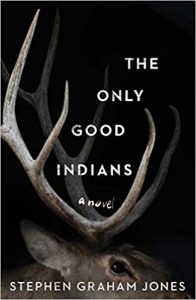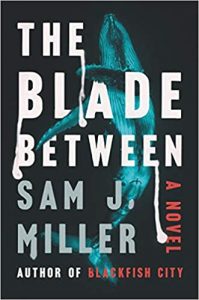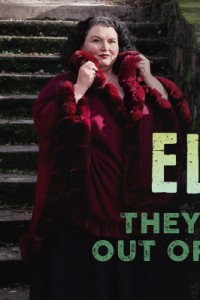Horrific Year, Superb Horror by Gabino Iglesias

We all know 2020 was a horrific year, but it was also a superb year for horror. As the world struggled through the pandemic, readers stuck at home turned to horror narratives as much – if not more so – than they regularly do because fictional horrors offer us an escape from real ones. As always, the genre delivered.
The greatness started early with Andy Davidson’s The Boatman’s Daughter, a book that seemed to be pulled from the muddy rivers of the South and carried all the spookiness and grit hidden in every bayou in this country. With great characterization and sharp prose, this early release was making lists at the end of the year, and deservingly so. Luckily for readers, that was just the beginning.
Stephen Graham Jones’s The Only Good Indians showed that horror fiction is often a mirror we hold up to ourselves. On one level, Jones crafted a creepy, gory narrative about supernatural revenge and guilt. On the other, he offered a brilliant deconstruction of Native American stereotypes and tackled themes like marriage between a Native American and a white person, living outside the reservation, and racism. If Mongrels can be called Jones’s breakout novel, the book that put him on every radar, then The Only Good Indians is the novel that cements him as a household name and one of the most creative and talented purveyors of horror fiction.
 Strangely enough, Jeremy Robert Johnson’s The Loop, which was released by Saga, just like The Only Good Indians, has nothing to do with Jones’s novel, but it could be considered its sister because both authors were well established before these books came out, but both reached new levels of success this year, and both books can arguably be called the best of their careers. In The Loop, Johnson explored the dystopian possibilities of technology in a story framed by youth, body horror, and friendship that was a standout and is still gaining momentum months after publication.
Strangely enough, Jeremy Robert Johnson’s The Loop, which was released by Saga, just like The Only Good Indians, has nothing to do with Jones’s novel, but it could be considered its sister because both authors were well established before these books came out, but both reached new levels of success this year, and both books can arguably be called the best of their careers. In The Loop, Johnson explored the dystopian possibilities of technology in a story framed by youth, body horror, and friendship that was a standout and is still gaining momentum months after publication.
If Jones and Johnson brought clear-cut horror to new heights, Maryse Meijer’s The Seventh Mansion reminded us that the genre can be as lyrical, profound, and strange as anything else out there. A story of love from beyond the grave with a strong religious undertone and a constant preoccupation with ecological troubles, this slim novel features healthy doses of tension and some of the strangest, eeriest love scenes of 2020.
While Meijer’s book has some historical elements, the best horror book with historical elements of 2020 is P. Djèlí Clark’s Ring Shout. Superbly written, mixing in fantasy and historical elements, and full of likeable characters and great dialogue, Ring Shout is an outstanding narrative that takes an unflinching look at the history of racism in the United States and invites us to obliterate it.
A late arrival that deserves mention is Sam J. Miller’s The Blade Between. A story about a small town fighting gentrification, about whales and people struggling to stop the destruction of everything they’ve known, it is also a dark, spooky tale about ghosts, hauntings, and how the violence and pain of the past can seep into the ground and affect the present.
While I usually don’t include many anthologies and collections in best-of lists, this year brought us two books that must appear here, or this would feel incomplete. The first is Laura van den Berg’s I Hold a Wolf by the Ears. Without a doubt, this was the best, darkest short story collection of 2020. The variety of stories here is staggering, but there is a sense of danger and underlying horror that serves as powerful elements of cohesion. From sadness, to disappearances, to ghosts and extreme violence, there is something in this one for everyone.
 The second collection that rose above everything else is Tiny Nightmares, edited by Lincoln Michel & Nadxieli Nieto. With a table of contents packed with names like Samantha Hunt, Sam J. Miller, Brian Evenson, Jac Jemc, Stephen Graham Jones, Corey Farrenkopf, Lilliam Rivera, Monique Laban, Hilary Leichter, Ben Loory, Kevin Brockmeier, and Rion Amilcar Scott, this collection of flash horror fiction is varied, wonderfully curated, and sustains a level of quality that pushed it to the top of the heap.
The second collection that rose above everything else is Tiny Nightmares, edited by Lincoln Michel & Nadxieli Nieto. With a table of contents packed with names like Samantha Hunt, Sam J. Miller, Brian Evenson, Jac Jemc, Stephen Graham Jones, Corey Farrenkopf, Lilliam Rivera, Monique Laban, Hilary Leichter, Ben Loory, Kevin Brockmeier, and Rion Amilcar Scott, this collection of flash horror fiction is varied, wonderfully curated, and sustains a level of quality that pushed it to the top of the heap.
A book that pushed its way into horror from the literary fiction side and surprised me was Joseph Fasano’s The Dark Heart of Every Wild Thing. Besides having one of the best titles of the year, this deceptively simple story of loss and vengeance in the wilderness turned out to be an emotionally gritty, violent, unflinchingly brutal tale that coated its very real horrors in superb prose.
While the preceding titles were perfect horror to read during the pandemic, Paul Tremblay’s Survivor Song was the perfect book about a pandemic to read during a pandemic. Heartfelt, fast-paced, and uncannily accurate in its depiction of our inability to deal with a pandemic, this book came uncomfortably close to reality, but Tremblay’s imagination and knack for complex characters made it a necessary read.
Lastly, there are other horror books that earned a mention here. Adam Cesare’s Clown in a Cornfield pushed the envelope in terms of brutality and gore in YA horror while offering a critique of social media and a surreptitiously political narrative. Mark Allan Gunnells’s 324 Abercorn took the classic haunted house story and turned it into a fresh narrative about new love and what it means to become a believer in the supernatural. Lastly, there are two great non-fiction books that are great additions to any horror lover’s library. The first is Unspeakable Acts, edited by Sarah Weinman. It explores some of the most violent, depraved, and devastating crimes in modern history and shows that sometimes real life can surpass horror fiction in terms of viciousness and destruction. Also, Magnetized by Carlos Busqued is an eerie and incredibly interesting book of translated conversations with Ricardo Melogno, an Argentinian serial killer who murdered four taxi drivers in Buenos Aires in 1982.
Perhaps the best thing about 2020 was the horror, and, looking at what’s coming in 2021, it looks like fans of the horrific will have much to celebrate in the year to come.
Gabino Iglesias is a writer, journalist, professor, and book reviewer living in Austin TX. He is the author of Zero Saints and Coyote Songs and the editor of Both Sides. His work has been nominated to the Bram Stoker and Locus Awards and won the Wonderland Book Award for Best Novel in 2019. His short stories have appeared in a plethora of anthologies and his non-fiction has appeared in the New York Times, the Los Angeles Times, and CrimeReads. His work has been published in five languages, optioned for film, and praised by authors as diverse as Roxane Gay, David Joy, Jerry Stahl, and Meg Gardiner. His reviews appear regularly in places like NPR, Publishers Weekly, the San Francisco Chronicle, Criminal Element, Mystery Tribune, Vol. 1 Brooklyn, the Los Angeles Review of Books, and other print and online venues. He’s been a juror for the Shirley Jackson Awards twice and has judged the PANK Big Book Contest, the Splatterpunk Awards, and the Newfound Prose Prize. He teaches creative writing at Southern New Hampshire University’s online MFA program. You can find him on Twitter at @Gabino_Iglesias.
This review and more like it in the February 2021 issue of Locus.
 While you are here, please take a moment to support Locus with a one-time or recurring donation. We rely on reader donations to keep the magazine and site going, and would like to keep the site paywall free, but WE NEED YOUR FINANCIAL SUPPORT to continue quality coverage of the science fiction and fantasy field.
While you are here, please take a moment to support Locus with a one-time or recurring donation. We rely on reader donations to keep the magazine and site going, and would like to keep the site paywall free, but WE NEED YOUR FINANCIAL SUPPORT to continue quality coverage of the science fiction and fantasy field.
©Locus Magazine. Copyrighted material may not be republished without permission of LSFF.








